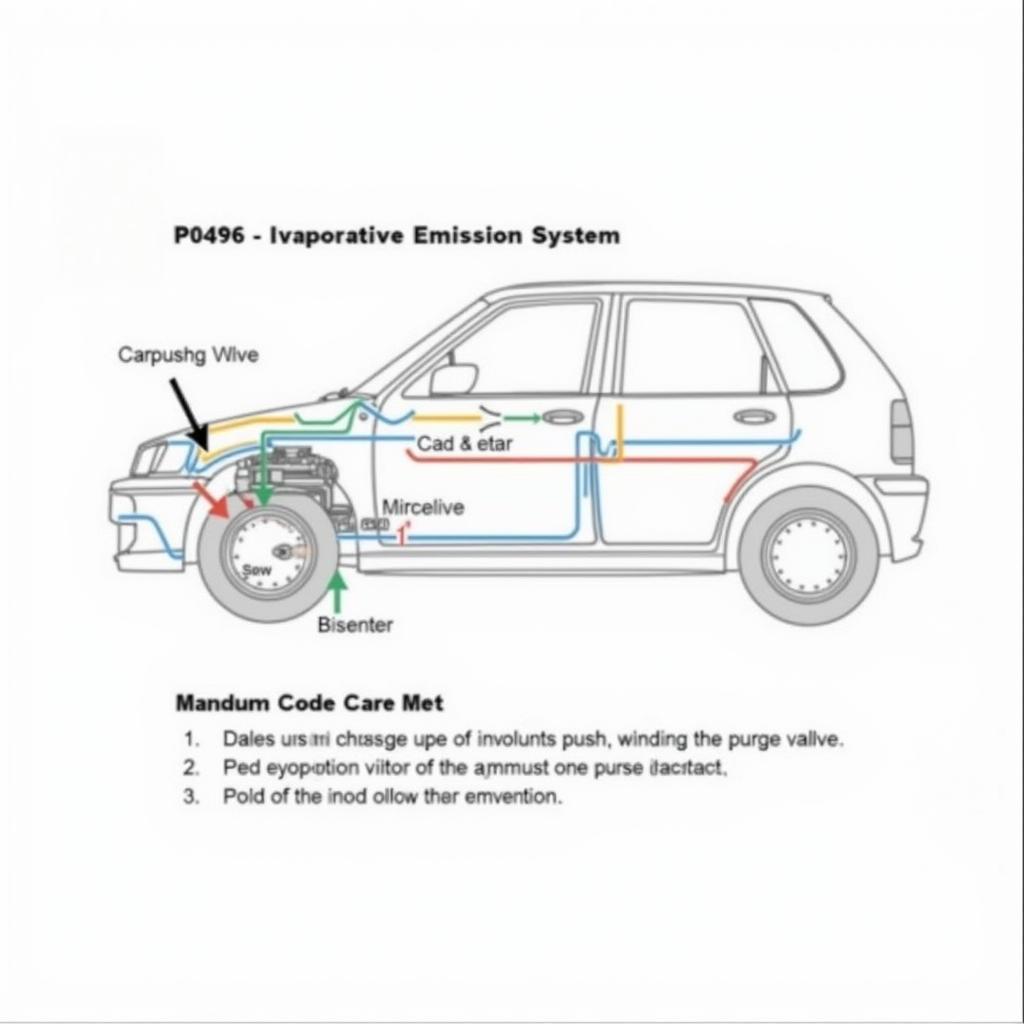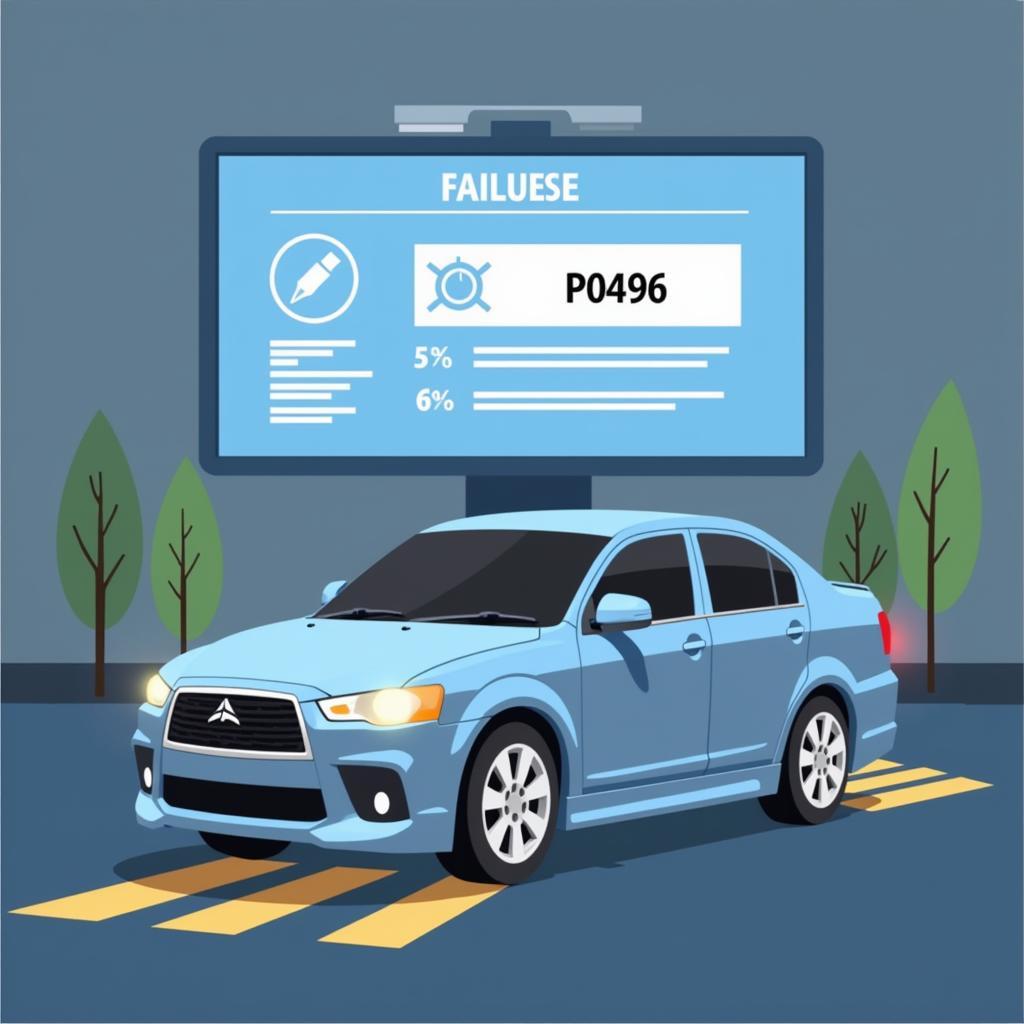If you’re seeing the dreaded P0496 code on your car’s diagnostic scanner, don’t panic. This article will walk you through understanding “How Do I Fix The Code 0496 On My Car”, its causes, and how to fix it. We’ll cover everything from simple checks you can do yourself to more complex repairs that might require a professional. Let’s dive in and get your car back on the road!
Understanding the P0496 Code: Evaporative Emission System High Purge Flow
The P0496 code indicates a problem with your car’s Evaporative Emission Control (EVAP) system. Specifically, it means the purge flow is higher than expected. The EVAP system prevents fuel vapors from escaping into the atmosphere. It does this by storing the vapors in a charcoal canister and then purging them into the engine to be burned. A P0496 code suggests something is causing excessive purging.
Common Causes of the P0496 Code
Several issues can trigger a P0496 code. Here are the most common culprits:
- Faulty Purge Valve: This valve controls the flow of vapors from the canister to the engine. If it’s stuck open, it can cause excessive purge flow.
- Vacuum Leaks: A leak in the vacuum lines connected to the EVAP system can disrupt the pressure and lead to the P0496 code.
- Blocked or Restricted EVAP Lines: Clogs or kinks in the lines can also disrupt the system’s pressure balance.
- Faulty Canister Purge Volume Control Solenoid: This solenoid works with the purge valve to regulate the flow of vapors. A malfunctioning solenoid can cause similar issues to a faulty purge valve.
- Faulty Fuel Cap: A loose or damaged fuel cap can allow fuel vapors to escape, triggering the code.
 Evaporative Emission System Diagram with P0496 Code Highlighted
Evaporative Emission System Diagram with P0496 Code Highlighted
Diagnosing and Fixing the P0496 Code
Here’s a step-by-step guide to help you diagnose and fix the P0496 code:
- Check the Gas Cap: Start with the simplest solution. Ensure the gas cap is tightly sealed. If it’s loose or damaged, replace it.
- Inspect Vacuum Lines: Carefully examine all vacuum lines connected to the EVAP system for cracks, leaks, or disconnections. Repair or replace any damaged lines.
- Test the Purge Valve: Locate the purge valve and check its operation. You can use a vacuum pump to test if it holds vacuum. If it doesn’t, replace the purge valve.
- Check the Canister Purge Volume Control Solenoid: Similar to the purge valve, you can test the solenoid with a multimeter to ensure it’s functioning correctly. Replace it if necessary.
- Inspect EVAP Lines for Blockages: Check the EVAP lines for any kinks, blockages, or restrictions. Clear any obstructions or replace damaged lines.
“A common mistake people make is assuming the purge valve is always the problem,” says John Miller, a certified automotive technician with over 20 years of experience. “Thoroughly checking all components of the EVAP system is crucial for an accurate diagnosis.”
What Happens if I Ignore the P0496 Code?
While the P0496 code might not immediately cause drivability issues, ignoring it can lead to:
- Increased Emissions: Your car will release more harmful vapors into the atmosphere.
- Failed Emissions Test: You’ll likely fail your state’s emissions inspection.
- Potential Engine Damage: In some cases, a faulty EVAP system can affect engine performance and potentially cause damage.
 Car Emissions Testing Showing P0496 Code Failure
Car Emissions Testing Showing P0496 Code Failure
“Addressing the P0496 code promptly not only ensures your car is environmentally friendly but also prevents potential future problems,” adds Maria Sanchez, an automotive engineer specializing in emissions control systems.
Conclusion: Fixing the P0496 Code on Your Car
Fixing the P0496 code involves systematically checking and repairing the components of your car’s EVAP system. While some fixes are simple DIY tasks, others may require professional assistance. Don’t let this code cause you unnecessary stress. By following the steps outlined in this guide, you can confidently diagnose and fix the issue, ensuring your car runs smoothly and passes emissions tests. If you need further assistance, connect with the experts at AutoTipPro at +1 (641) 206-8880 or visit our office at 500 N St Mary’s St, San Antonio, TX 78205, United States. We’re here to help you get back on the road!





Leave a Reply